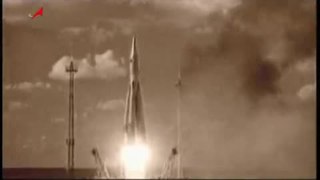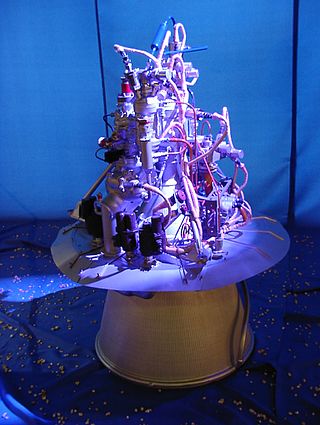
Luna 2, originally named the Second Soviet Cosmic Rocket and nicknamed Lunik 2 in contemporaneous media, was the sixth of the Soviet Union's Luna programme spacecraft launched to the Moon, E-1 No.7. It was the first spacecraft to reach the surface of the Moon, and the first human-made object to make contact with another celestial body.

Luna 9 (Луна-9), internal designation Ye-6 No.13, was an uncrewed space mission of the Soviet Union's Luna programme. On 3 February 1966, the Luna 9 spacecraft became the first spacecraft to achieve a survivable landing on a celestial body and return imagery from its surface.

The Soviet space program was the national space program of the Union of Soviet Socialist Republics (USSR), active from 1955 until the dissolution of the Soviet Union in 1991.

A Moon landing or lunar landing is the arrival of a spacecraft on the surface of the Moon, including both crewed and robotic missions. The first human-made object to touch the Moon was Luna 2 in 1959.

Luna E-1 No.2, sometimes identified by NASA as Luna 1958B, was a Soviet spacecraft which was lost in a launch failure in 1958. It was a 361-kilogram (796 lb) Luna E-1 spacecraft, the second of four to be launched. It was intended to impact the surface of the Moon, and in doing so become the first man-made object to reach its surface.

Luna E-1 No.3, sometimes identified by NASA as Luna 1958C, was a Soviet spacecraft which was lost in a launch failure in 1958. It was a 361-kilogram (796 lb) Luna E-1 spacecraft, the third of four to be launched, all of which were involved in launch failures. It was intended to impact the surface of the Moon, and in doing so become the first man-made object to reach its surface.

The Molniya, GRAU Index 8K78, was a modification of the well-known R-7 Semyorka rocket and had four stages. The rocket was given the name Molniya due to the large number of Molniya communication satellites the rockets launched.
Luna E-1A No.1 or E-1 No.5, sometimes identified by NASA as Luna 1959A, was a Soviet spacecraft which was lost in a launch failure in 1959. It was a 387-kilogram (853 lb) Luna E-1A spacecraft, the first of two to be launched. It was intended to impact the surface of the Moon, and in doing so would have been the first man-made object to reach its surface.
Luna E-3 No.1, sometimes identified by NASA as Luna 1960A, was a Soviet spacecraft which was lost in a launch failure in 1960. It was a 279-kilogram (615 lb) Luna E-3 spacecraft, the first of two to be launched, both of which were lost in launch failures. It was intended to fly around the Moon on a circumlunar trajectory in order to image the surface of the Moon, including the far side. The E-3 spacecraft were similar in design to the E-2A which had been used for the earlier Luna 3 mission. However, they carried higher resolution cameras, and were intended to make closer flybys.
Luna E-3 No.2, sometimes identified by NASA as Luna 1960B, was a Soviet spacecraft which was lost in a launch failure in 1960. It was a 279-kilogram (615 lb) Luna E-3 spacecraft, the second of two to be launched, both of which were lost in launch failures. It was intended to fly around the moon on a circumlunar trajectory in order to image the surface of the Moon, including the far side. The E-3 spacecraft were similar in design to the E-2A which had been used for the earlier Luna 3 mission. However, they carried higher-resolution cameras, and were intended to make closer flybys.
Luna E-6LS No.112, sometimes identified by NASA as Luna 1968A, was a Soviet spacecraft which was lost in a launch failure in 1968. It was a 1,700-kilogram (3,700 lb) Luna E-6LS spacecraft, the second of three to be launched. The spacecraft was intended to enter Selenocentric orbit, where it would study the Moon, and demonstrate technology for future crewed Lunar missions.
Luna E-8 No.201, also known as Luna Ye-8 No.201, and sometimes identified by NASA as Luna 1969A, was a Soviet spacecraft which was lost in a launch failure in 1969. It was a 5,590 kilograms (12,320 lb) Luna E-8 spacecraft, the first of three to be launched. It was intended to perform a soft landing on the Moon, in order to deploy a Lunokhod rover onto the surface. It carried the Lunokhod No.201 rover.
Luna E-8-5 No.402, also known as Luna Ye-8-5 No.402, and sometimes identified by NASA as Luna 1969C, was a Soviet spacecraft under Luna programme which was lost in a launch failure in 1969. It was a 5,600-kilogram (12,300 lb) Luna E-8-5 spacecraft, the first of at least eleven to be launched. It was intended to perform a soft landing on the Moon, collect a sample of lunar soil, and return it to the Earth. It was, along with Luna 15, one of two unsuccessful missions which had been launched by the Soviet Union in a last-ditch attempt to upstage the Apollo 11 landing under Moon race.

Luna E-8-5 No.405, also known as Luna Ye-8-5 No.405, and sometimes identified by NASA as Luna 1970A, was a Soviet spacecraft which was lost in a launch failure in 1970. It was a 5,600-kilogram (12,300 lb) Luna E-8-5 spacecraft, the fifth of eight to be launched. It was intended to perform a soft landing on the Moon, collect a sample of lunar soil, and return it to the Earth.

The LK was a lunar module developed in the 1960s as a part of several Soviet crewed lunar programs. Its role was analogous to the American Apollo Lunar Module (LM). Three LK modules, of the T2K variant, were flown without crew in Earth orbit, but no LK ever reached the Moon. The development of the N1 launch vehicle required for the lunar flight suffered setbacks, and the first Moon landings were achieved by US astronauts on Apollo 11. As a result, having lost the Space Race, both the N1 and the LK programs were cancelled without any further development.

Soyuz 7K-L1 No.4L, sometimes identified by NASA as Zond 1967A, was a Soviet spacecraft which was launched in 1967 as part of the Zond programme. It was a 5,390-kilogram (11,880 lb) Soyuz 7K-L1 spacecraft, the first of nine to be launched. Although it was intended to perform a circumlunar flyby of the Moon before returning to the Earth for landing, it failed to achieve Earth orbit.

The Molniya-M, GRAU designation 8K78M, was a Soviet Union launch vehicle derived from the R-7 Semyorka Intercontinental ballistic missile (ICBM).

The Luna 8K72 vehicles were carrier rockets used by the Soviet Union for nine space probe launch attempts in the Luna programme between 23 September 1958 and 16 April 1960. Like many other Soviet launchers of that era, the Luna 8K72 vehicles were derived from the R-7 Semyorka design, part of the R-7, which was also the basis for the Vostok and modern Soyuz rocket.

The RD-0109 is a rocket engine burning liquid oxygen and kerosene in a gas generator combustion cycle. It has single nozzle and is an evolution of the RD-0105. It was the engine used on the Vostok Block-E that launched Yuri Gagarin to orbit.
Zond program was a Soviet robotic spacecraft program launched between 1964 and 1970, using two spacecraft series, one for interplanetary exploration, and the other for lunar exploration.












